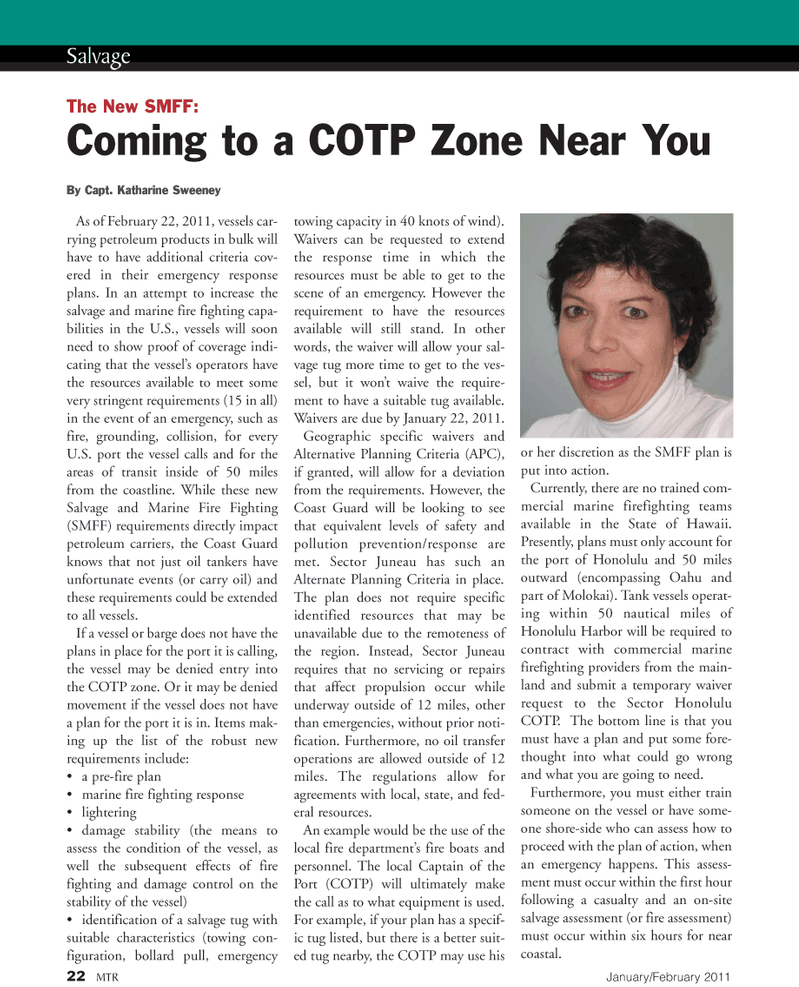
Page 22: of Marine Technology Magazine (January 2011)
Marine Salvage & Recovery
Read this page in Pdf, Flash or Html5 edition of January 2011 Marine Technology Magazine
22 MTR January/February 2011
As of February 22, 2011, vessels car- rying petroleum products in bulk will have to have additional criteria cov- ered in their emergency response plans. In an attempt to increase the salvage and marine fire fighting capa- bilities in the U.S., vessels will soon need to show proof of coverage indi- cating that the vessel’s operators have the resources available to meet some very stringent requirements (15 in all) in the event of an emergency, such as fire, grounding, collision, for every
U.S. port the vessel calls and for the areas of transit inside of 50 miles from the coastline. While these new
Salvage and Marine Fire Fighting (SMFF) requirements directly impact petroleum carriers, the Coast Guard knows that not just oil tankers have unfortunate events (or carry oil) and these requirements could be extended to all vessels.
If a vessel or barge does not have the plans in place for the port it is calling, the vessel may be denied entry into the COTP zone. Or it may be denied movement if the vessel does not have a plan for the port it is in. Items mak- ing up the list of the robust new requirements include: • a pre-fire plan • marine fire fighting response • lightering • damage stability (the means to assess the condition of the vessel, as well the subsequent effects of fire fighting and damage control on the stability of the vessel) • identification of a salvage tug with suitable characteristics (towing con- figuration, bollard pull, emergency towing capacity in 40 knots of wind).
Waivers can be requested to extend the response time in which the resources must be able to get to the scene of an emergency. However the requirement to have the resources available will still stand. In other words, the waiver will allow your sal- vage tug more time to get to the ves- sel, but it won’t waive the require- ment to have a suitable tug available.
Waivers are due by January 22, 2011.
Geographic specific waivers and
Alternative Planning Criteria (APC), if granted, will allow for a deviation from the requirements. However, the
Coast Guard will be looking to see that equivalent levels of safety and pollution prevention/response are met. Sector Juneau has such an
Alternate Planning Criteria in place.
The plan does not require specific identified resources that may be unavailable due to the remoteness of the region. Instead, Sector Juneau requires that no servicing or repairs that affect propulsion occur while underway outside of 12 miles, other than emergencies, without prior noti- fication. Furthermore, no oil transfer operations are allowed outside of 12 miles. The regulations allow for agreements with local, state, and fed- eral resources.
An example would be the use of the local fire department’s fire boats and personnel. The local Captain of the
Port (COTP) will ultimately make the call as to what equipment is used.
For example, if your plan has a specif- ic tug listed, but there is a better suit- ed tug nearby, the COTP may use his or her discretion as the SMFF plan is put into action.
Currently, there are no trained com- mercial marine firefighting teams available in the State of Hawaii.
Presently, plans must only account for the port of Honolulu and 50 miles outward (encompassing Oahu and part of Molokai). Tank vessels operat- ing within 50 nautical miles of
Honolulu Harbor will be required to contract with commercial marine firefighting providers from the main- land and submit a temporary waiver request to the Sector Honolulu
COTP. The bottom line is that you must have a plan and put some fore- thought into what could go wrong and what you are going to need.
Furthermore, you must either train someone on the vessel or have some- one shore-side who can assess how to proceed with the plan of action, when an emergency happens. This assess- ment must occur within the first hour following a casualty and an on-site salvage assessment (or fire assessment) must occur within six hours for near coastal.
Salvage
The New SMFF:
Coming to a COTP Zone Near You
By Capt. Katharine Sweeney

 21
21

 23
23
